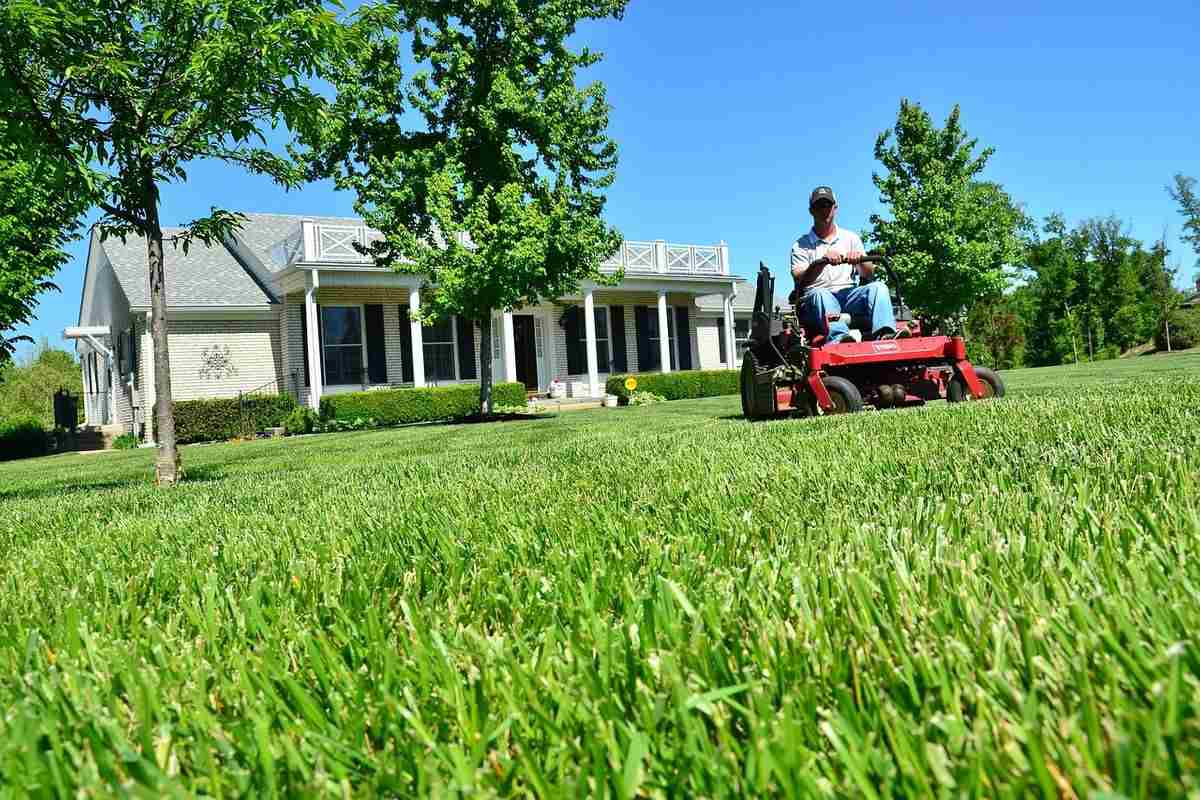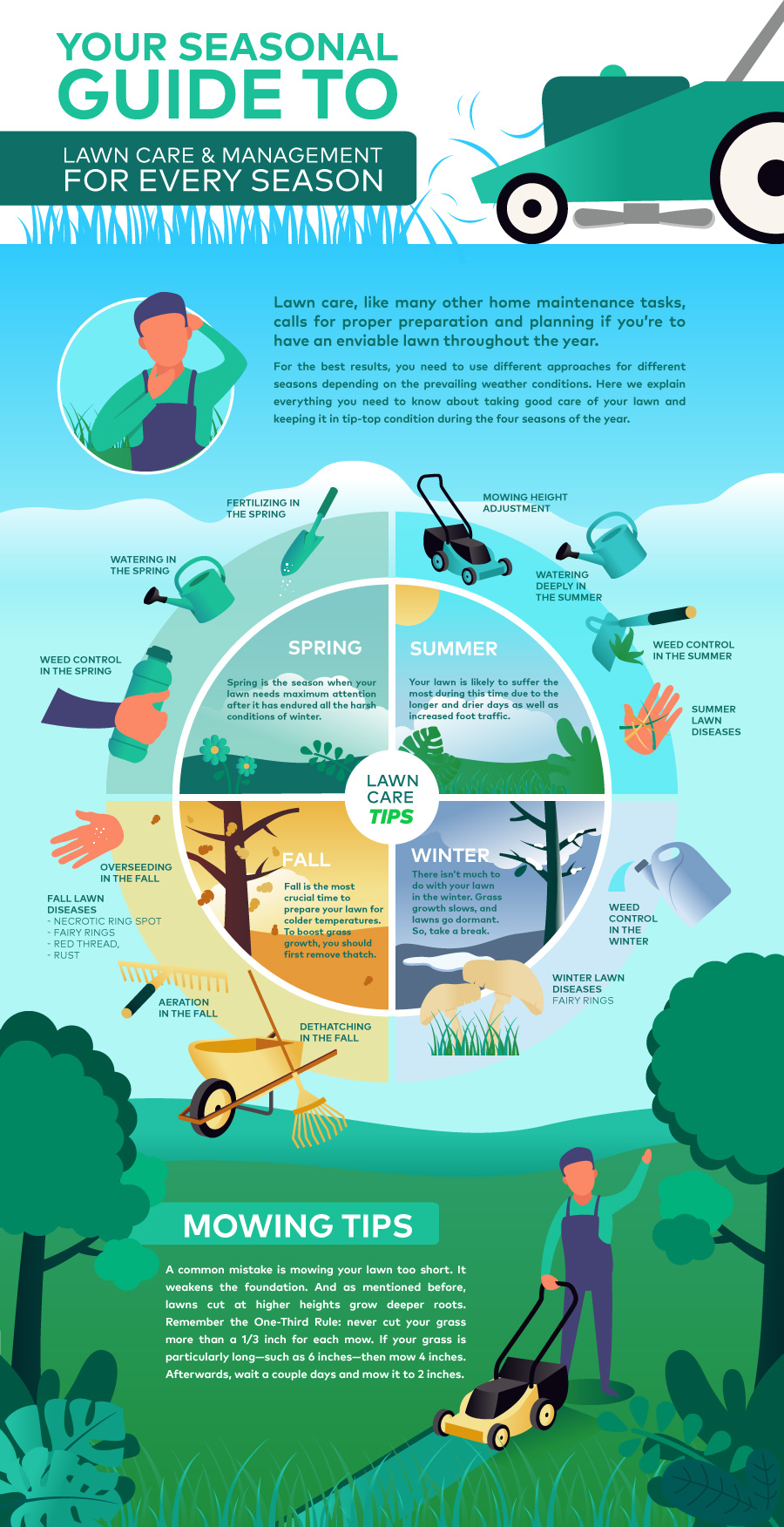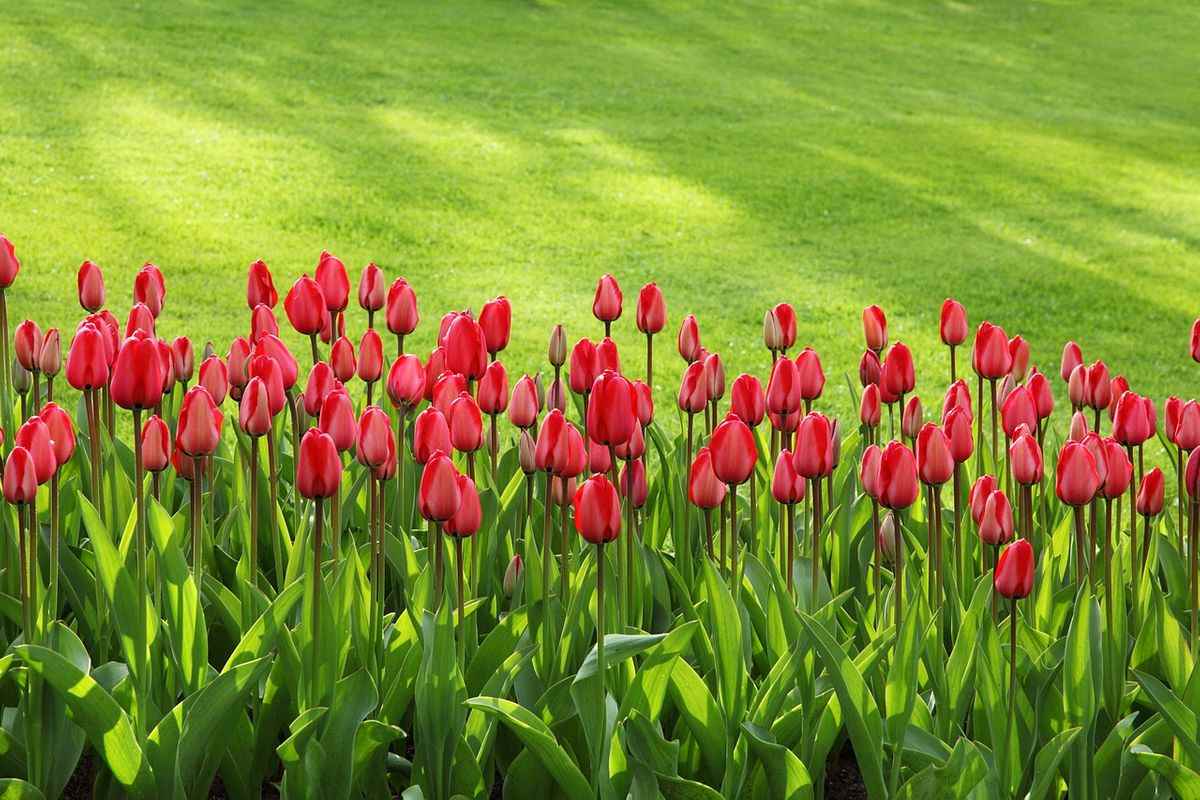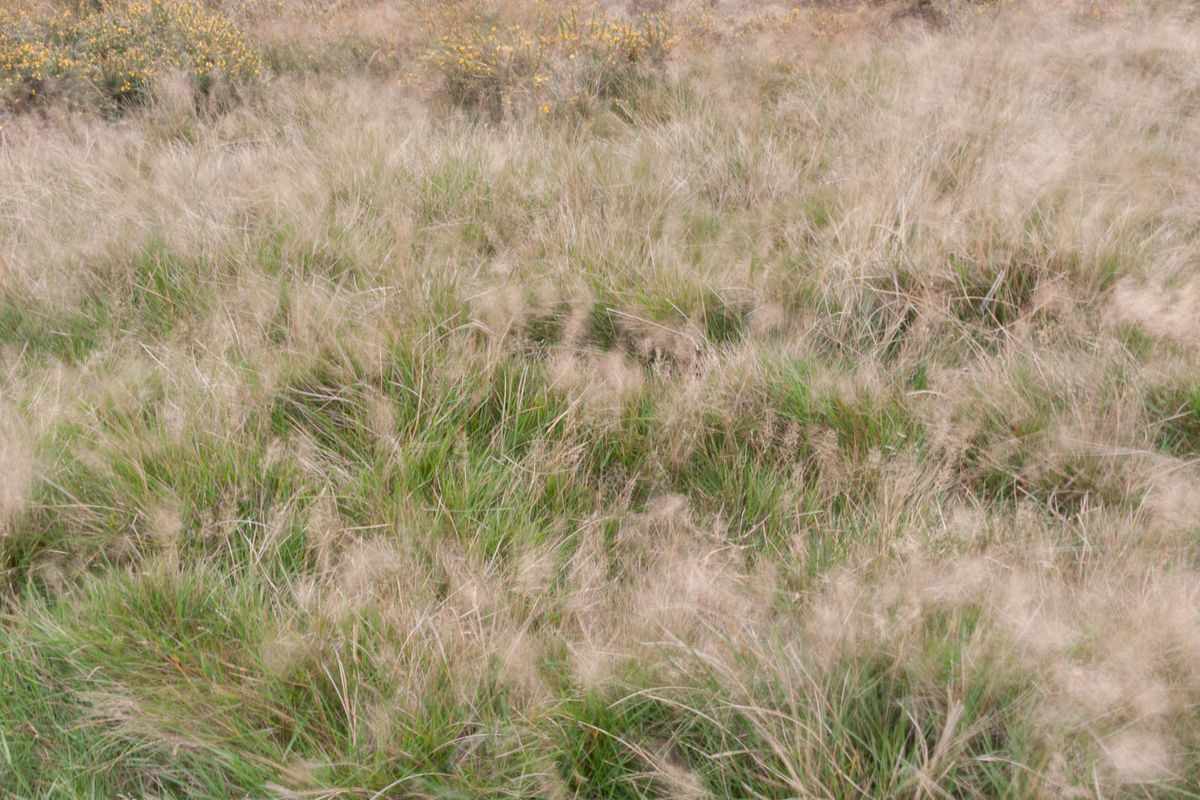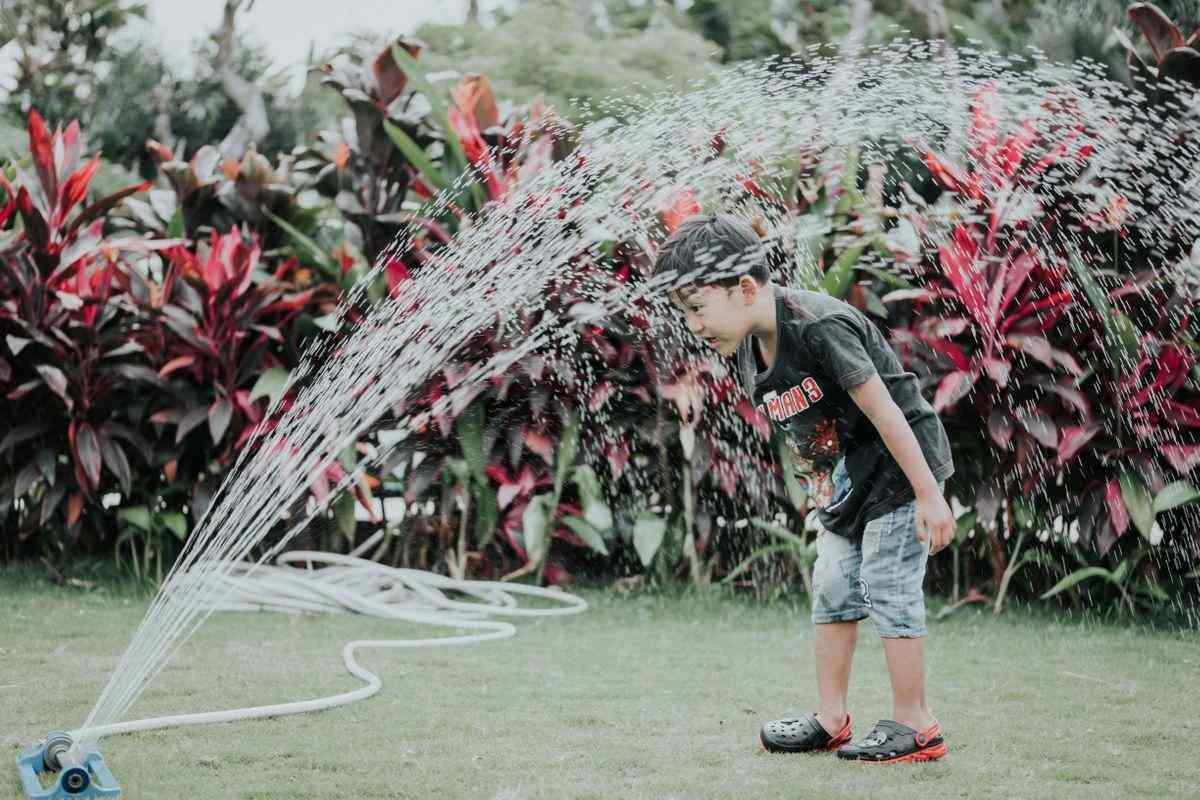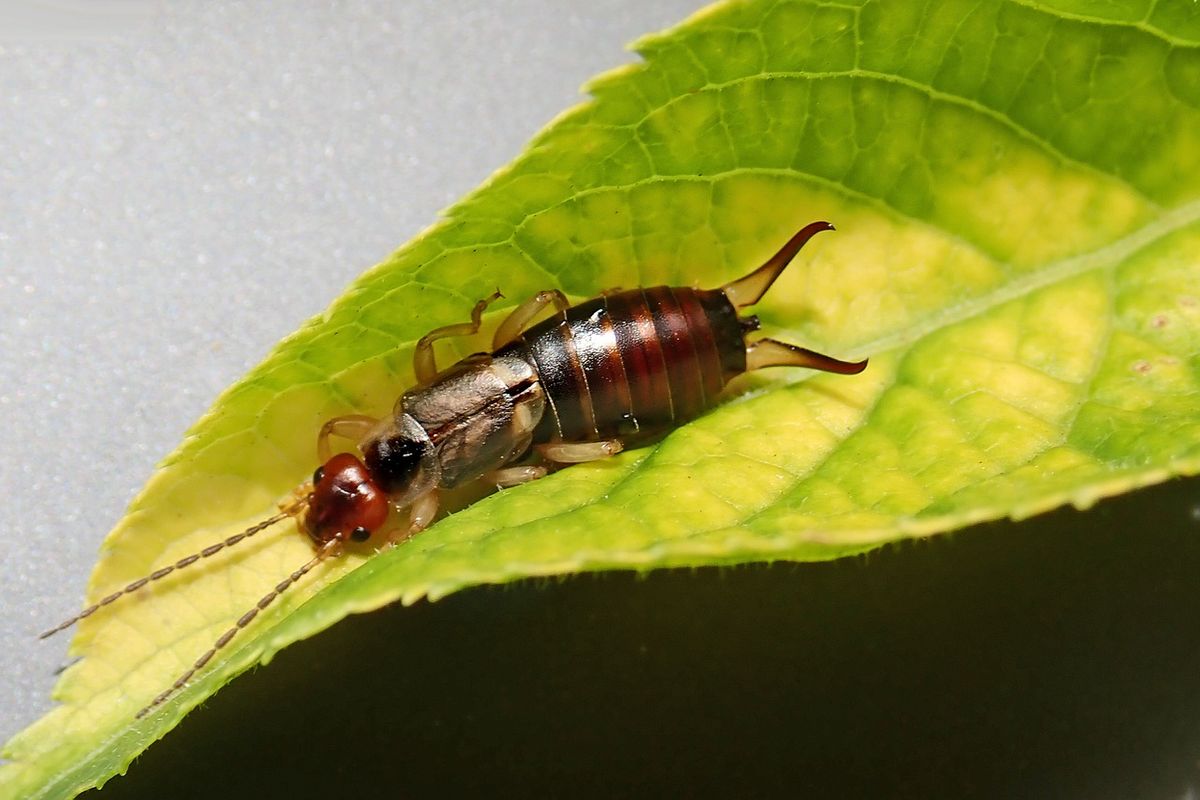Lawn Care 101: Your Seasonal Guide to Lawn Care & Maintenance
Let’s admit it; a healthy and lush lawn is every homeowner’s dream. It not only improves the general appearance and value of your home but also provides a space for your family and friends to enjoy. Lawn care, like many other home maintenance tasks, calls for proper preparation and planning if you’re to have an enviable lawn throughout the year.
For the best results, you need to use different approaches for different seasons depending on the prevailing weather conditions. In this comprehensive guide, we explain everything you need to know about taking good care of your lawn and keeping it in tip-top condition during the four seasons of the year. Inside, we will show you when to (or not to) mow, fertilize, seed/overseed, aerate, dethatch, water, and treat.
And that’s not all.
We’ve also compressed the most important tips into a downloadable infographic. Get your copy below and if possible, even print it out for use as a point of reference whenever you want to prepare for a new season.
Ready? Let’s get started!
Spring Lawn Care Tips
Spring is the season when your lawn needs maximum attention after it has endured all the harsh conditions of winter. Whatever you do during this season will determine how healthy or unhealthy your lawn looks for the next several months.
Feeding in the spring
After winter, your lawn may begin to turn greener, but don’t apply fertilizer just yet. According to the University of Connecticut’s Home & Garden Education Center, you should wait until your grass actually grows before you can start fertilizing it. The reason for this is that its roots still store enough carbohydrates from last fall to facilitate early spring growth. As a general rule of thumb, fertilizer tends to be more useful after a plant has exhausted its own resources.
For the best results, go for organic or light, slow-release types of fertilizers to ensure you’re not burning your possibly weakened lawn (after the harsh winter weather). Besides, liquid feeds and tonics are more recommended than granular fertilizers for quicker absorption by the plants. If you’re unsure about the most appropriate fertilization schedule to use for proper lawn care during spring, don’t hesitate to consult a professional lawn care professional for advice.
Watering in the spring
You should water your lawn no more than an inch a week. During this season, there’s still a lot of moisture in the soil, and you can test this by digging into the soil using a screwdriver. If the tool goes in with relative ease, then your lawn isn’t parched yet.
If you live in an area with regular rainfall, avoid turning your sprinkler system back on. Overwatering your lawn will drown the roots and encourage weed growth. The best time to start watering your lawn in spring is after grass starts to show signs of wilting. It is during this time that plants grow more and deeper roots which come in handy during those extended dry periods later in the summer.
Overseeding in the spring
Overseeding is the process of replenishing grass by scattering grass seeds over a lawn. Spring is a good time to overseed, particularly if you’re using turf grasses that are known to grow robustly in these conditions.
However, there is a debate on whether overseeding for cool-season turfgrasses is effective or not during spring. New seeds for these kinds of grasses only tend to grow shallow roots since the higher temperatures in the following summer cause photorespiration. This is the process where a plant uses more energy than it manufactures. But if your lawn has warm-season turfgrasses, then overseeding is generally recommended around this time.
Under normal circumstances, you’ll only need to overseed twice a year unless your lawn suffered severe damage in winter.
Pest control in the spring
As the spring weather warms the soil, earthworms and other bugs emerge toward the upper soil levels—but moles can return as well. Moles attack and damage the root systems of lawns in their search for worms and other food. Most moles in North America are found in the eastern U.S. and Canada. The most common family of moles in the U.S. is the Eastern mole—generally found in the Southeast and Northeast.
They’re a pest throughout spring, summer, and fall. However, the best time to lay mole traps is during the spring just before they build more tunnels. According to UConn’s Home & Garden Education Center, homeowners need to simply place a harpoon trap in the main tunnel, use a toxic bait (which is usually gummy-worm shaped), or try these other recommended methods.
Weed control in the spring
Weeds, such as crabgrass, begin to germinate during late spring and emerge fully during the summer, but you can curb and eliminate their presence. The product you’ll need to use here is pre-emergent herbicide. According to Pennsylvania State University’s Center for Turfgrass Science, the pre-emergent herbicide is the most critical component of an effective chemical control program. These herbicides are readily found in supermarkets and should be applied 10-14 days before the germination periods of weeds.
Later on in spring, you may consider using post-emergent herbicides to control any grassy or broadleaf weeds that often show up during summer.
Dethatching and aeration in the spring
Remove any leaves and twigs that might have accumulated on your lawn over the winter using leaf rakes and similar tools. Cleaning up these old debris paves the way for easy application of herbicides and fertilizers.
Also, don’t forget to aerate the soil on a day when soil is slightly damp but not soaked. This helps to ensure that oxygen, water, and nutrients from feeds reach roots for healthy lawn growth.
Spring lawn diseases
The University of Wisconsin compiled a list of common lawn diseases throughout all four seasons. During spring, there are four diseases to watch out for including Snow Mold (if your area receives snowfall), Necrotic Ring Spot, Fairy Rings, and Red Thread.
Summer Lawn Care Tips
When it comes to lawn care, the majority, if not all, of us do it with summer in mind. It is during this season that lawns are used intensively as nearly everyone is spending more time outdoors and having lots of fun. As you can imagine, your lawn also is likely to suffer the most during this time due to the longer and drier days as well as increased foot traffic. But don’t worry as we’re about to show you easy tips to help you keep this space in its best possible condition.
Mowing in the summer
Mowing height adjustment is probably the most important practice to prepare lawns for hot weather. The reason is that lawns maintained at taller lengths, at least three inches or slightly higher, develop deeper root systems. Avoid mowing too frequently, especially if your lawn has cool-season turfgrasses. Their growth naturally slows down when temperatures become hotter and drier. Weekly mowing is reasonable and recommended. This will prevent you from cutting more than a third of the grass blade at a time which is key in keeping your grass looking healthier and stronger.
If you have cool-season grass in your lawn, mow it at 3-4 inches while for warm-season grass, that level should be down to about 2-3 inches high. After mowing, leave the clippings as mulch to keep moisture levels steady throughout the hot days.
Always use sharp mower blades to ensure that you’re cutting and not tearing the grass. Dull blades can harm and increase stress to your grass which is exactly what you want to avoid with all the unforgiving summer heat.
Watering in the summer
Summer is the time to turn your sprinkler system back on. Watering your lawn deeply during this hot season is crucial to the development of deep root systems, which are the basis for resilient and durable lawns. Deeply-rooted turf grass can withstand stressful weather conditions much better than shallow-rooted plants. Be sure to water deeply as this promotes the development of deep root systems.
But what does it mean to water deeply? The answer depends on your soil type:
- Sandy soil should be watered 0.8 to 1.2 inches per foot.
- Loam soil should be watered 1.8 inches to 2.4 inches per foot.
- Clay soil should be watered 2.2 inches to 3.2 inches per foot.
Once you determine the soil type of your lawn, you need to set the appropriate sprinkler time. The Soak and Cycle method is the best measurement you can use here:
- Take empty containers and spread them across your lawn.
- Turn on your sprinkler system for 15 minutes, then measure the containers with a ruler. Afterwards, turn on the sprinkler for another 15 minutes, then measure again.
- These measurements should help you determine the flow rate of your sprinkler heads. Time your sprinkler system to the appropriate amount of water that your soil type needs.
Proper distribution of sprinkled water is key in preventing brown patches in your lawn and also enhancing the health of your grass.
The best time to water your lawn is early in the morning before the sun rises too high. If you water in the afternoon, it will evaporate before your lawn can adequately absorb it. And if you water at night, your lawn will remain wet overnight and become prone to diseases.
Don’t forget to also account for rainwater every time you’re watering your lawn. If there have been instances of showers during the week, you won’t need to water your lawn as often. If you use an advanced irrigation system, you may want to adjust your timers depending on the changing weather patterns. Also, be sure to inspect your system for blockages and leaks for effective results.
Weeds and pest control in the summer
Weeds sprout in the summer and can become more visible and even overshadow grass on your lawn if not controlled. For those who missed the window during spring to use pre-emergent herbicide, there’s still a chance to remove the weeds from your lawn. The two main methods of weed removal are cultural control and chemical control.
“Cultural control involves hand weeding, followed by creating an adequate growing environment for the turf species present,” says Sam Bauer, Executive Director of the North Central Turfgrass Association. Chemical control, Bauer adds, involves using “post-emergent herbicides containing the active ingredients quinclorac or fenoxaprop.”
Cultural control is a quick remedy if your lawn is only sparsely populated with weeds. Just bend down and pluck them (easy weeds to pick are dandelions and broadleaves). Chemical control is a better solution if your lawn is heavily populated by weeds. Bauer recommends these products with the essential active ingredients: “fenoxaprop-P-ethyl (Bayer Crabgrass Killer for Cool-Season Lawns) or quinclorac (Bayer All-In-One Weed and Crabgrass Killer, Ortho Weed-B-Gon + Crabgrass Killer, others).” Only spray herbicides when temperatures are below 85° F to avoid stressing your grass any further.
In the same vein, don’t forget to treat for common lawn pests that show up in summer. Some insects like turf caterpillars and grubs are quite harmful, especially if left to multiply uncontrolled. Be on the lookout for symptoms of pest infestation like wilting and unusually high feeding activity. If the pest infestation looks to be extreme, consider hiring a lawn care company to help you eradicate them.
Potentially disastrous pests that should be in your watch include sod webworms which often appear in June. These feed on grass blades and can wipe out your entire lawn in days. Grub worms are another family of pests that can cause extensive damage to your lawn during the summer months of July and August. In most cases, these pests cause a scorched appearance on the grass to deprive your lawn of that lush green color you’ve worked so hard to maintain. Others common outdoor pests to look out for include aphids, carpenter ants, fleas, chinch bugs, caterpillars.
Summer lawn diseases
During the summer, there are six common diseases to watch out for including Necrotic Ring Spot, Fairy Rings, Summer Patch, Dollar Spot, Powdery Mildew, Red Thread, and Rust. Most of these summer lawn diseases are fungal, which means you will need to apply an appropriate fungicide as advised by an expert. You also need to avoid watering in the evenings as this is often the chief cause of fungal diseases.
Fall Lawn Care Tips
With the harsh winter climatic conditions on the way and the environment turning brown with every passing day, this is your final chance of the year to maintain a good-looking lawn. What you need to keep in mind here is that any lawn care activities you do during this season will reap fruits in months to come – more of a long-term strategy for your lawn.
Dethatching in the fall
As we just mentioned, fall is the most crucial time to prepare your lawn for the upcoming colder temperatures. To boost grass growth, you should first remove thatch – the build-up that accumulates over your lawn. While you should dethatch in every season, fall generally produces the most thatch, usually small branches and fallen leaves. Excessive accumulation of these materials will eventually suffocate your lawn as they block vital sunlight rays and trap excessive moisture.
The common dethatching tools you can use here are vertical mowers and power rakes. For larger lawns, vertical mowers work a lot better and are easier to use. To avoid ripping up your turf grass, set the blades high before your first run. Afterwards, you can always adjust accordingly. For smaller lawns, power rakes are an easier alternative. You’ll have more hand control when you remove material from your lawn.
Aeration in the fall
Virtually all lawns benefit from aeration. This is the practice of breaking down compacted soil by plugging holes into your lawn. The goal is to allow water and nutrients to reach the roots more easily. However, not all parts of your lawn need to be aerated equally. According to Clemson University’s Home & Garden Information Center, aeration is needed more in grass areas with frequent foot traffic. The center recommends either of these two tools for aeration: a spading fork or a core aerator.
A spading fork is excellent for small lawns. Stab the ground four inches deep with the tool’s thick tines, then rock it back and forth. This movement will loosen the soil and make room for new grass-roots.
A core aerator is better for larger lawns and is less labor-intensive. Adjust the height of the tines—which usually are between three-quarters of an inch to an in-depth three inches—and run the machine across your lawn. Aeration is most recommended just before fertilizing your lawn to allow penetration of nutrients to the roots.
Overseeding in the fall
Cold temperatures can make turf grasses brown. But if you overseed in the fall, this is avoidable. This season is the last growing period of the year, so overseeding is essential, even if you did it in the spring.
The amount you overseed depends on the type of turfgrass you have in your yard. If your lawn is comprised of warm-season turfgrass, Virginia Tech provides a useful list. If your lawn has cool-season turfgrass, University of Massachusetts Amherst provides a useful list as well.
During the overseeding process also, you may consider introducing more resilient grasses that can withstand the harsher climatic conditions of winter and summer. While at it, ensure that the seeds you’re spreading in the thin spots or bare patches get into good contact with the soil. Thereafter, water them until they germinate. The core goal is to ensure that the grasses are well established before winter comes.
Fertilizing in the fall
Lawns are less likely to brown if you apply a slow-release fertilizer in early fall. When shopping for these fertilizers, buy products with controlled-release nitrogen. The steady release of nitrogen helps grass retain its green color. The amount to apply varies slightly based on the type of turfgrass you are using. Most individual applications, however, are around 1 pound of nitrogen per 1,000 square feet. Where possible, use fertilizers that also contain potassium which is known to aid in root growth, drought tolerance, and disease resistance. For example, you may apply a 24-0-10 granular fertilizer where those numbers indicate the ratio of nitrogen, phosphorous, and potassium, respectively.
A general tip here is that you should never fertilize a dry lawn. Instead, fertilize after rainfall or after you have finished watering for the best results. Be careful not to miss any spots in your lawn when fertilizing to facilitate uniform growth of grasses. For best results, consider using a walk-behind drop spreader although you could still opt for a crank-style broadcaster if the former is not available.
Weed control in the fall
Some weeds persist during this season, even if you already treated your lawn in the past spring and summer. The University of Maryland offers a free and encompassing database of lawn weeds. Once identified, quickly apply herbicides on the weeds before the temperatures drop. Otherwise, the weeds will become dormant and remain preserved until spring (though some die naturally from the cold).
Mowing in the fall
It’s not winter yet and this means you cannot afford to put that mower away. While the temperatures might not be very conducive, grass continues to grow albeit at a slower rate compared to summer. As such, you will need to cut it regularly and try to keep it at 2-3 inches high. Leaving it to grow too tall will make it vulnerable to fungal diseases like snow mold. Cutting it too short is also not recommended as it ends up curtailing root growth and ultimately impedes your lawn’s ability to endure dryness and the winter cold.
Watering in the fall
The weather is cooler during fall but let that not fool you into thinking that your lawn doesn’t need watering. Sure, there may be some rain and dew falling but the total amount of water could be lower than what your grass requires for optimal growth and survival. If your lawn is not getting at least an inch of water per week, you need to keep that sprinkler on, preferably till the end of October.
Fall lawn diseases
These are the four most common fall lawn diseases to watch out for including Necrotic Ring Spot, Fairy Rings, Red Thread, and Rust. If you notice signs of an outbreak of any of them, contact your local lawn care experts for advice on how to stop them from spreading on your lawn.
Winter Lawn Care Tips
The extreme nature of winter means there’s very little you can do on your lawn to save the grass from browning or even dying from the freezing ice. However, this doesn’t mean you should ignore it completely. For example, you should continue doing regular maintenance work and taking care of grass in preparation for the upcoming and more favorable spring. The following are simple tricks you can try to keep your lawn healthy during winter.
Prepare early
Unless you stay in the south where winter is not too harsh, it is practically not possible to keep working on your yard in the freezing days of winter. As such, the best advice is to plan for it early and finish doing what you need to do outside before winter strikes. For example, you can start by raking away all dead leaves from fall to prevent the formation of wet spots and moldy patches. Additionally, it’s important to help every family member respect the lawn during this dormancy period by keeping away from it or parking their trucks or cars there. There’s nothing that kills lawn grasses and invites weeds faster than using the lawn as a parking lot.
Weed control in the winter
This is the primary lawn care for this season. Annual cool-season weeds grow and flourish during this time if the summer heat didn’t kill them. A lawn care guide from North Carolina State University suggests these weeds can be controlled with store-shelf herbicides. They should contain a mixture of 2, 4-D, mecoprop, and dicamba.
Dethatching in the winter
One of the most important tasks you can do on your lawn during winter is to ensure it is cleaned up at all times. Never leave debris, children toys, lawn furniture, or plant leaves out on the grass. This is to avoid smothering the grass, inviting harmful pests, or creating favorable conditions for diseases. An exception to this rule is when the leaves are not too thick or wet and can therefore serve as mulch and add nutrients to the grass.
Raking and watering in the winter
Sometimes the soil becomes so hard during winter that water cannot penetrate to the roots. To avert the dangers that may arise from such conditions, try dragging a rake over your lawn to help break down the soil clumps and cover any seeds still lying on the bare ground. You can then water the yard using a garden hose spray if there isn’t enough moisture in the soil.
Winter lawn diseases
The only lawn disease to look out for during winter is Fairy Rings—typically caused by thick layers of thatch.
General Lawn Care Tips
Regardless of the season, there are general lawn care guidelines to bear in mind. The following tips are largely drawn from the prolific writings of Sandra Mason, an extension lecturer of horticulture at the University of Illinois.
Mowing tips
A common mistake that most homeowners make is mowing their lawn too short. Doing this weakens the foundation and reduces the lifespan of lawn grasses and plants. On the other hand, lawns cut at higher heights grow deeper roots.
Remember the One-Third Rule: never cut your grass more than a 1/3 inch for each mow. If your grass is particularly long—such as 6 inches—then mow 4 inches. Afterwards, wait a couple days and mow it to 2 inches. Never reduce from say 6 inches to 2 inches in a single mow.
Except for winter, you should mow your lawn between 2 to 4 times a month. Frequent mowing prevents the build-up of thatch. Also, alternate your mowing pattern especially when using a riding mower. Doing so can reduce soil compaction in certain areas. When there is a drought, mow your lawn less frequently. And during rainy seasons, avoid mowing wet grass.
Also, leave behind short grass clippings after you mow as they decompose to become a nutrient-rich fertilizer for your lawn. Grass clippings are 75 to 85 percent water, so they integrate quickly into your lawn and won’t become thatch. However, this is the case as long as your lawn is frequently cut and properly fertilized.
Finally, be sure to pick the best type of lawn mower for your property. There are several different types of lawn mowers to choose from depending on the size of your lot, how many intricacies your yard has, and whether you have to deal with hills or not.
Lawn service pro or DIY lawn care?
Although this lawn care guide is as lengthy as it already is, the expertise of a lawn service professional may be more helpful and efficient. An experienced lawn service pro identifies lawn diseases more quickly and possibly diagnoses the needs of your lawn with more accuracy.
They are also often equipped with effective herbicide, pest-control, aeration and other lawn care tools. If you rather not pay for a $100 plus core aerator and avoid all the labor, then hire a lawn service pro. However, you might have to deal with a few issues when you decide to hire lawn care services. One, pros tend to overuse chemicals during lawn care, and two, they are usually not too flexible with your immediate needs. After all, other customers are waiting for them. Regardless, choosing either this or DIY lawn care simply depends on your needs.
Sources Used in this Article: Farmer Jane Texas A&M University of Florida Nutrilawn
